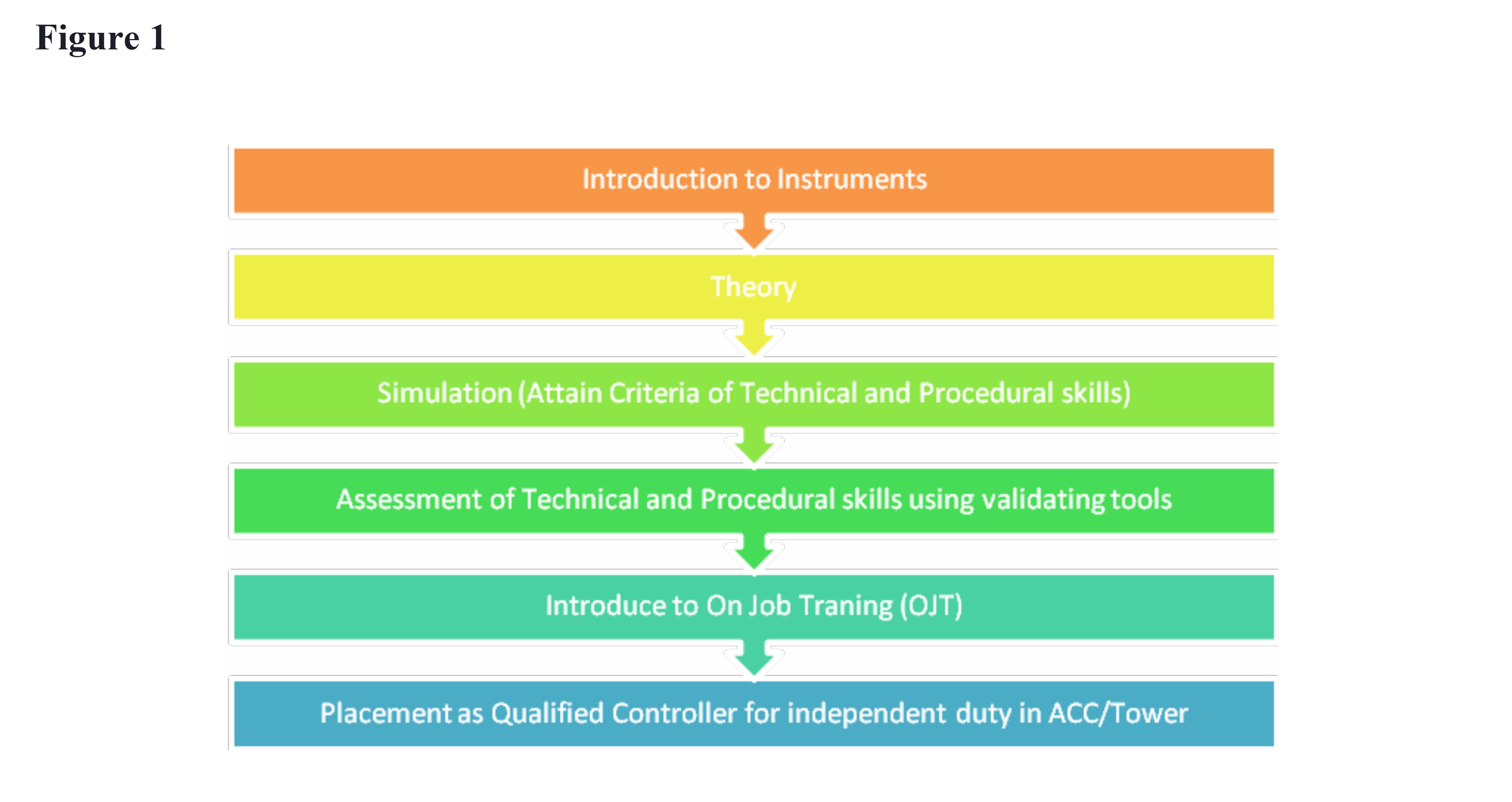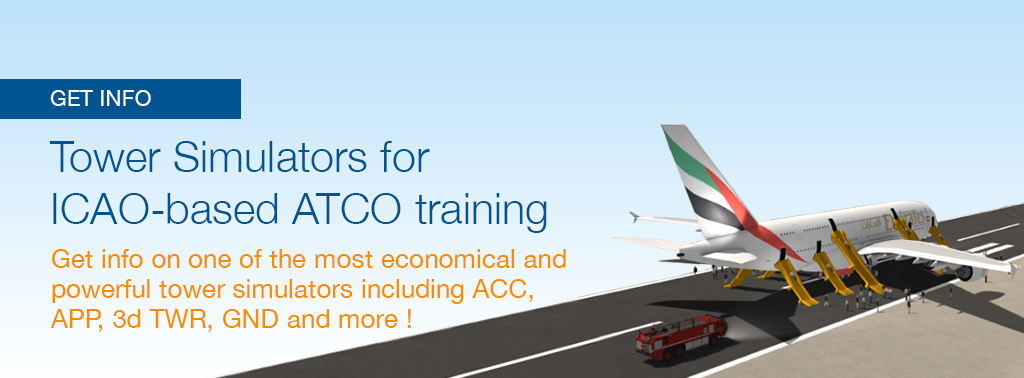For the acquisition of technical and procedural skills, both training institutions and individuals have to play an active role. While talking about the role of an Institution in acquiring these skills, let’s look at Pre Traffic training through simulators and training radars and see how this is embedded into the trainees overall qualification journey.
Before proceeding with our topic, it’s worthwhile to understand what are skills and what stands to be the difference between “Technical” and “Procedural” skills. Skills are abilities that are acquired through learning and practice.
Remaining confined to the borders of Air Traffic Control, we require an excellent set of skills to bring smoothness and accuracy into our complex operations. In ATC we are confronted with a variety of situations. Depending on the constraints offered by a situation, we employ different decision-making techniques.
Normally the life of an Air Traffic Controller at the workplace is surrounded by complex situations that require a multifaceted decision-making process. In such an emergent situation we are having constraints like shortage of time, excessive compulsory requirements, sudden unavailability of certain facilities, malfunctioning of equipment, etc.
Heuristic Techniques for Training and Qualification
Because of such limitations and a variety of situations, we are required to utilize different types of heuristics [1]. As an Air Traffic Controller, you will utilize heuristics when one or a combination, or all of the following five conditions are met (Praktanis, 1989)
-
When faced with too much information. (Route Restrictions coupled with Bad Weather)
-
When the time for decision making is limited. (Pressurization Failure)
-
When the decision to be made is unimportant. (WX request coupled with a fake warning)
-
When having little information for decision making. (Radar Failure)
-
When encountering an appropriate heuristic at the same moment. (Alternate Separation)
Working backward is a useful heuristic in which you begin solving the problem by focusing on the result.
As we have become aware of the sort of decision making that is involved in ATC. Now we are confronted with an imminent question like “How can we improve our Heuristic Approach?”
Like all other decision-making strategies, its efficiency is based on the quality of “Technical” and “Procedural” skills acquired by an Air Traffic Control Officer. Most probably you are now asking yourself the question “How can we acquire these skills?” or "How can be teach pass these skills to our trainees?"
 Here we will revert to the definition of Skills. Skills are acquired when we undergo a process of learning AND PRACTICE.
Here we will revert to the definition of Skills. Skills are acquired when we undergo a process of learning AND PRACTICE.
But just learning these skills will not be enough. To acquire these skills we need to make them a part of our second nature through practice. Without being expert at these skills we cannot bring smoothness and efficiency in operations.
Technical Skills entail more like mechanical drawings, engineering, etc. whereas procedural skills are more like writings involving series of technical details for example as soon as an air traffic services unit learns that an aircraft is being intercepted in its area of responsibility, it shall take specified steps mentioned in the Annex 11 (Air Traffic Services) to restore situation to normal conditions.
For many airlines, a successful flight operation depends on having a well-managed technical and procedural aspects the job defined and documented for the flight crew and Air Traffic Controllers.
Technical and procedural competency is the keystone of the aviation industry. In normal jobs, we can have acceptance for deviations from the normal course of action. But in the Aviation industry specifically, Air Traffic Control services accuracy is required in technical and procedural measures. Even a minor deviation can produce catastrophic results. The investigation on the deadly collision at LAX on Runway 24 L revealed that two airliners were instructed to use runway 24L at the same time. A single human error resulted in catastrophic results.
For the acquisition of technical and procedural skills, both institutions and individuals have to play an active role. While talking about the role of an Institution in acquiring these skills, we should take a look at Pre Traffic training in the ATC training institutions.
A Word on Training Radars and Simulators
Perfection is an outcome of practice and practice is acquired through repetitive interaction in technical or realistic modality. Training in Air Traffic Services for Tower and Area Control Center is being carried out through the utilization of Tower and Radar Simulators and training radars.
Simulators are are optimized training environments that provide a realistic imitation of controls and operations. Incorporation of reality in some advance simulators is made possible through designing simulators with the capability to import live data into simulation scenarios. This real-time data creates a scenario that possesses impressions of reality hence providing an opportunity for a trainee to learn and experience pressure on dealing a real scenario. A Radar Simulator provides realistic imitation for handling Approach and Enroute Traffic whereas Tower Simulators are designed to portray a realistic environment for practicing over ATC Tower operations and controls.
Training radars are optimized to train the principles, configuration and use of radars in the ATCO and ATSEP world.
NavAids simulators support the training of ILS, DME, VOR etc for operations as well as for service qualification.
A trainee not only learns techniques but acquires perfection in performance through these tools. Air Traffic services inherently require zero error policy to meet superlative safety and productivity standards. Through the acquisition of perfection, a trainee acquires increased operational efficiency and improved decision making.
Pre-Traffic training on Simulators and Training Radars
 Pre-training for technical and procedural skills should involve the following major components, which should be done outside the workplace settings.
Pre-training for technical and procedural skills should involve the following major components, which should be done outside the workplace settings.
-
The cognitive knowledge surrounding air traffic services.
-
Standard operating procedures, those pertain to Air Traffic Services.
-
Instructions in basic, generic enabling skills that will prepare Air Traffic Controllers by giving them the fundamental elements needed to handle the specific situation.
-
Employing virtual reality training to experience and exercise acquired knowledge and understanding.
The educational experience of these simulations can be enhanced by designing traffic focused, realistic scenarios involving simulated traffic situations. During all of these elements, learners must have access to expert instructors and teachers who provide the summative [2] and formative evaluation.
 Through interaction with the learning environment and discharging learned techniques and practices, students attain proficiency and smoothness in the application of procedures. They become acquainted with the environment to a specific technical and procedural level.
Through interaction with the learning environment and discharging learned techniques and practices, students attain proficiency and smoothness in the application of procedures. They become acquainted with the environment to a specific technical and procedural level.
This acquaintanceship with the expected working environment brings understand and confidence in them. This confidence and knowledge create a bridge for them in getting interwoven with the real working environment and to its conditions.
In Pre-Traffic Training a student undergoes a number of phases starting from Introduction to instruments being utilized in air traffic control services.
In the second phase focus will be on equipping the candidate with prerequisite knowledge to help him acquire required procedural and technical skills.
In the next phase, the student will be exposed to a prototype environment (simulation or pedagogically enhanced radar or navigation environment) to experience real-time scenarios. In this phase, the candidate will learn through the cognitive domain various technical and procedural skills through the application of technical and procedural inputs being taught.
By blending learning and application of procedures, the process of skill acquisition is completed and students will acquire the required skills for their profession.
In the fourth stage, deficits among students are assessed and corrective actions are taken. As a consequence of this stage some students may be reverted to the position where shortcomings occurred.
You can perceive it as a feedback stage within a model. Apart from this feedback stage, every phase is having its feedback mechanism that feeds consequential results to previous stages.
But this feedback mechanism aims mainly at implementing quality in standards - it will never expose a student.
Finally, in the fifth stage, a student equipped with minimum criteria of technical and procedural skills is introduced to the real working environment. Here the student will apply all the technical and procedural skills in a real-time environment.
Maximum skill acquisition starts at the final stage where a student stands alone in terms of learning and practice. We can relate it to “Necessity is the mother of invention”. It becomes necessary for a student in a real environment to meet tough standards of air traffic control services. And to achieve this requirement he strives hard and practically utilizes it in a real environment.
Options for an Individual to Learn
Now let’s talk about available options for an Individual to learn these skills. Learning and practice are for life long period specifically when it relates to field like air traffic control services. I have pointed out air traffic control services because this field is enriched in terms of technical and procedural changes that are brought about by the introduction of new technological and procedural changes. We can take an example of an air traffic route structure and significant point names that change after every successive or random interval based on the requirements of a Country and International Civil Aviation Authority laid down standards. With changes in route structures and names of significant points, it becomes inevitable for a controller to learn emergent modified technical aspects (RNP10, RNP 5, etc.) and new procedures related to it like approach procedures, Standard Instrument Arrivals, etc.
To acquire technical and procedural skills, an individual should utilize the following options:
Reading
How to be procedurally and technically well versed requires a habit to read and an inquisitive nature. E.g. a situation has risen like turbulence which is a weather phenomenon. The student needs to know what turbulence is? When does turbulence occur in their air space? How can air traffic controllers serve the aircraft experiencing turbulence?
Going through all the content about air traffic services not only helps controllers to develop understand, but it also makes them confident in the application of procedures.
We all have heard about “go by the book”. ATC is all about going by the book to ensure accuracy and standardization. Hence through reading books, a controller not only acquires technical information that leads towards the acquisition of technical skills, but it also does help them in familiarizing with laid down procedures.
They must study all requisite SOPs, Manuals, Books, Annexure, in fact, all relevant documents. Doing so, they will have a better understanding of technical and procedural aspects. Air traffic services procedures are learned from documents like ICAO, FAA, or JEPPSEN.
What procedures the trainees should follow mostly it is dependent on region. America uses the FAA, most European countries follow ICAO. In ICAO all the procedures are documented in the form of Annexes and Documents. In order to have a good grip on procedures, air traffic controllers must learn the standards they are following.
Brainstorming
It is one of the very useful mental exercises to acquire these skills. An air traffic controller should always spend some time brainstorming with colleagues and fellow controllers about the possibility of an alternate solution for specific scenarios and wise switch among utilization of alternate equipment. In this way, a controller can acquire vital information regarding technical and procedural matters. For instance, we take an example of a skilled controller sharing information regarding a lack of procedures for handling VFR flight in night time at the main runway in case of electricity failure causing blackout at the runway.
Simulation Exercises
In air traffic control services simulators are always available at key locations. Individuals are informed to participate. If there are no simulators improvised simulation techniques can help an individual or a trained controller in the acquisition of technical and procedural skills. The controller should always be an active participant in these exercises. They should apply all possible technical and procedural alternatives to test and verify accuracy and effectiveness. Doing so tested and verified information will turn into important tools for dealing with a variety of scenarios.
Talking to an Expert Air Traffic Controller
It is known that a wise man always learns from the experience of others. Spend some time with expert and knowledgeable controllers, as they will provide you anecdotal information and experience of their work-life that will add a lasting touch to your set of skills without investing much.
They are always enriched with fabulous information about changing patterns of technical and procedural measures that will add the most expensive gems to the ring of your skills. You will learn the pattern and can perceive and foresee upcoming changes in equipment and procedures based on it.
And in this way, your learning will help you in getting familiar with changing trends of technical and consequential procedures. And sudden changes for others will be a matter of common experience for you.
Perform Ordinary
Sometimes things that might appear ordinary reveal to be the most extraordinarily important aspect of our job. Hence an individual should give importance to even minute details related to job and workplace. He or she should learn to operate all equipment and manage technical aspects and get acquainted with them. Like a controller applying different separation standards relate to the scenario being generated instead of employing the same technique for all situations. Bringing variety into practice will help in acquiring and enhancing technical as well as procedural skills.
References and Further Reading
- The Cognitive Representation of Attitudes (1989), Anthony R. Pratkanis
- [1] Wikipedia defines a heuristic technique (/hjʊəˈrɪstɪk/; Ancient Greek: εὑρίσκω, "find" or "discover"), or a heuristic for short, is any approach to problem solving or self-discovery that employs a practical method that is not guaranteed to be optimal, perfect or rational, but which is nevertheless sufficient for reaching an immediate, short-term goal. Where finding an optimal solution is impossible or impractical, heuristic methods can be used to speed up the process of finding a satisfactory solution. Heuristics can be mental shortcuts that ease the cognitive load of making a decision. Examples that employ heuristics include using trial and error, a rule of thumb, an educated guess, an intuitive judgment, a guesstimate, profiling, or common sense.
- [2] Summative assessment, summative evaluation, or assessment of learning refers to the assessment of participants where the focus is on the outcome of a program. The goal of summative assessment is to evaluate student learning at the end of an instructional unit by comparing it against a standard or benchmark. Summative is being used as combined conclusion. (source: Cambridge Dictionary)





